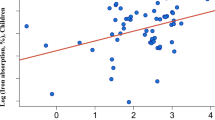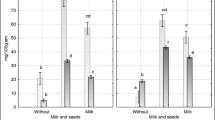Abstract
Iron (Fe) and zinc’s (Zn) interaction at the absorptive level can have an effect on the success of co-fortification of wheat flour with both minerals on iron deficiency prevention. The aim of the study was to determine the effect of increasing levels of zinc fortificant on the iron absorption of bread co-fortified with iron and zinc consumed with a black tea. Twelve women aged 33–42 years participated in the study. They received on four different days 200 mL of black tea and 100 g of bread made with wheat flour (70 % extraction) fortified with either 30 mg Fe/kg alone, as ferrous sulfate (A), or with the same Fe-fortified flour, but with graded levels of Zn, as zinc sulfate: 30 mg/kg (B), 60 mg/kg (C), or 90 mg/kg (D). Fe radioisotopes (59Fe and 55Fe) of high specific activity were used as tracers, and Fe absorption iron was measured by the incorporation of radioactive Fe into erythrocytes. The geometric mean and range of ±1 SD of Fe absorption were as follows: A = 6.5 % (2.2–19.3 %), B = 4.6 % (1.0–21.0 %), C = 2.1 % (0.9–4.9 %), and D = 2.2 % (0.7–6.6 %), respectively; ANOVA for repeated measures F = 10.9, p < 0.001 (Scheffè’s post hoc test: A vs. C, A vs. D, B vs. C, and B vs. D; p < 0.05). We can conclude that Fe absorption of bread made from low-extraction flour fortified with 30 mg/kg of Fe, as ferrous sulfate, and co-fortified with zinc, as zinc sulfate consumed with black tea is significantly decreased at a zinc fortification level of ≥60 mg/kg flour.
Similar content being viewed by others
References
Hurrell R, Ranum P, de Pee S, Biebinger R, Hulthen L, Johnson Q, Lynch S (2010) Revised recommendations for iron fortification of wheat flour and an evaluation of the expected impact of current national wheat flour fortification programs. Food Nutr Bull 31(suppl 1):S7–S21
Brown KH, Hambidge KM, Ranum P, Zinc Fortification Working Group (2010) Zinc fortification of cereal flours: current recommendations and research needs. Food Nutr Bull 31(suppl 1):S62–S74
Whittaker P (1998) Iron and zinc interactions in humans. Am J Clin Nutr 68:442S–446S
Olivares M, Pizarro F, Ruz M, de Romaña DL (2012) Acute inhibition of iron bioavailability by zinc: studies in humans. Biometals 25:657–664
Herman S, Griffin IJ, Suwarti S, Ernawati F, Permaesih D, Pambudi D, Abrams SA (2002) Cofortification of iron-fortified flour with zinc sulfate, but not zinc oxide, decreases iron absorption in Indonesian children. Am J Clin Nutr 76:813–817
Olivares M, Pizarro F, López de Romaña D (2013) Effect of zinc sulfate fortificant on iron absorption from low extraction wheat flour co-fortified with ferrous sulfate. Biol Trace Elem Res 151:471–475
Núñez MT, Olivares M (2010) Nutritional aspects of iron metabolism. In: Avigliano L, Rossi L (eds) Biochemical aspects of human nutrition. Transworld Research Network, Kerala, pp 87–99
Lönnerdal B (2000) Dietary factors influencing zinc absorption. J Nutr 130:1378S–1383S
Disler PB, Lynch SR, Charlton RW, Torrance JD, Bothwell TH, Walker RB, Mayet F (1975) The effect of tea on iron absorption. Gut 16:193–200
Eakins JD, Brown DA (1966) An improved method for the simultaneous determination of iron-55 and iron-59 in blood by liquid scintillation counting. Int J Appl Radiat Isot 17:191–197
Nadler SB, Hidalgo JU, Bloch T (1962) Prediction of blood volume in normal human adults. Surgery 51:224–232
Bothwell TH, Finch CA (1962) Iron metabolism. Little Brown, Boston
Fischer DS, Price DC (1964) A simple serum iron method using the new sensitive chromogen tripyridyl-s-triazine. Clin Chem 10:21–31
International Anemia Consultative Group (1985) Measurement of iron status. A report of the International Anemia Consultative Group (INACG). Nutrition Foundation, Washington DC
WHO, FAO, UNICEF, GAIN, MI, FFI (2009) Recommendations on wheat and maize flour fortification. Meeting Report: Interim Consensus Statement. World Health Organization, Geneva. http://www.who.int/nutrition/publications/micronutrients/wheat_maize_fort.pdf. Accessed 10 April 2013
López de Romaña D, Salazar M, Hambidge KM, Penny ME, Peerson JM, Sian L, Krebs NF, Brown KH (2005) Iron absorption by Peruvian children consuming wheat products fortified with iron only or iron and one of two levels of zinc. Proceedings of FASEB Experimental Biology, San Diego, 2–6 April 2005 (Abstract 274.23)
Peña G, Pizarro F, Hertrampf E (1991) Contribution of iron of bread to the Chilean diet. Rev Med Chile 119:753–757
Flanagan PR, Cluett J, Chamberlain MJ, Valberg LS (1985) Dual-isotope method for determination of human zinc absorption: the use of a test meal of turkey meat. J Nutr 115:111–122
Sreenivasulu K, Raghu P, Nair KM (2010) Polyphenol-rich beverages enhance zinc uptake and metallothionein expression in Caco-2 cells. J Food Sci 75:H123–H128
Acknowledgments
The study was supported by grant 1100094 from FONDECYT-Chile. The authors would like to express their gratitude to all the women who participated in the study and to Ms. Angelica Letelier for her technical assistance.
Author information
Authors and Affiliations
Corresponding author
Rights and permissions
About this article
Cite this article
Olivares, M., Castro, C., Pizarro, F. et al. Effect of Increasing Levels of Zinc Fortificant on the Iron Absorption of Bread Co-Fortified with Iron and Zinc Consumed with a Black Tea. Biol Trace Elem Res 154, 321–325 (2013). https://doi.org/10.1007/s12011-013-9741-5
Received:
Accepted:
Published:
Issue Date:
DOI: https://doi.org/10.1007/s12011-013-9741-5




